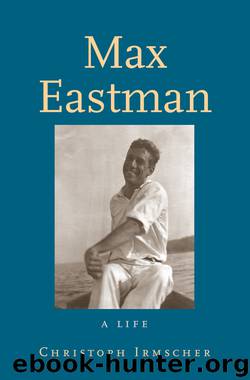Max Eastman: A Life by Christoph Irmscher

Author:Christoph Irmscher [Irmscher, Christoph]
Language: eng
Format: epub
Tags: Literary Criticism, American, General
ISBN: 9780300222562
Google: t0wmDwAAQBAJ
Amazon: 0300222564
Publisher: Yale University Press
Published: 2017-01-15T00:39:16.675000+00:00
Some of Max’s identity problems were reflected in the hero of Max’s novel, Venture, a book left unfinished for years after he had first begun working on it in his dingy little room in Sochi. The novel’s protagonist, the rather transparently named Jo Hancock, a college dropout and poet of modest ability, bore many features of Max himself, as Sinclair Lewis accurately perceived, mixed in with the muscularity and adventurousness of John Reed. And while Jo shared some features with other young men exposed to radical ideas—such as Hal Warner in Upton Sinclair’s King Coal (1917) and Billy in Ernest Poole’s The Harbor (1915)—Max’s novel follows its own course by presenting Jo as really invested in two or perhaps three worlds: that of capitalist entrepreneurship, where he is quite successful, labor activism, and, last but not least, poetry. Jo’s clever business idea—to deliver freshly roasted coffee via milk wagons to grocery stores all over New York, a “smooth-running New Yorker’s utopia,” a dream of a delightfully caffeinated city opening their wallets to him—is progressive enough to make it not entirely unbelievable that, in his other life, he would fall under the influence of the IWW organizer Bill Haywood and join and support the silk strikers of Paterson, New Jersey. Neither George Forbes, a Nietzschean businessman who encourages Jo’s capitalist aspirations, nor the leaders of the strike know about the extent of Jo’s double life. Rather than relieving the reader of the ambiguities the novel has created around Jo, its ending reinforces them. Jo’s friends in Paterson discover that he is a bourgeois, his main investor pulls out, and his business fails before it even gets started. Jo’s love interest in the novel is Vera, the daughter of one of the strike leaders, a proletarian, Russian version of Florence Deshon with a sprinkling of Eliena’s wholesomeness and her gray eyes and prominent cheekbones. After Jo owns up to Forbes, Vera bestows a soft kiss upon him. But even that doesn’t yet release Jo from the prison of indecision he has created for himself, as the novel’s last sentence indicates: “He thought that perhaps real life can be lived after all—if you only make a few fundamental decisions.”20
The Boni brothers published the book in November 1927, as bad luck would have it, the same month as Thornton Wilder’s The Bridge of San Luis Rey, whose fame would eclipse Venture. Max’s novel wasn’t well served by the Bonis, who were equally lackluster in promoting Marx, Lenin, the other Eastman book they had taken on, under the title Marx and Lenin: The Science of Revolution. Max had expected so much more from them. After leaving Boni and Liveright, the firm he cofounded with Horace Liveright, Albert Boni had joined forces with his younger brother Charles to create an imprint that would publish innovative contemporary writers. Among their authors, apart from Wilder, were William Carlos Williams, Ford Madox Ford, and Marcel Proust in C. K. Moncrieff’s translation; in 1925 they had published the iconic anthology The New Negro.
Download
This site does not store any files on its server. We only index and link to content provided by other sites. Please contact the content providers to delete copyright contents if any and email us, we'll remove relevant links or contents immediately.
| Africa | Asia |
| Canadian | Europe |
| Holocaust | Latin America |
| Middle East | United States |
Fanny Burney by Claire Harman(26526)
Empire of the Sikhs by Patwant Singh(22974)
Out of India by Michael Foss(16791)
Leonardo da Vinci by Walter Isaacson(13181)
Small Great Things by Jodi Picoult(7019)
The Six Wives Of Henry VIII (WOMEN IN HISTORY) by Fraser Antonia(5394)
The Wind in My Hair by Masih Alinejad(5033)
A Higher Loyalty: Truth, Lies, and Leadership by James Comey(4843)
The Lonely City by Olivia Laing(4747)
The Crown by Robert Lacey(4722)
Millionaire: The Philanderer, Gambler, and Duelist Who Invented Modern Finance by Janet Gleeson(4374)
The Iron Duke by The Iron Duke(4291)
Papillon (English) by Henri Charrière(4195)
Sticky Fingers by Joe Hagan(4100)
Joan of Arc by Mary Gordon(4013)
Alive: The Story of the Andes Survivors by Piers Paul Read(3967)
Stalin by Stephen Kotkin(3875)
Aleister Crowley: The Biography by Tobias Churton(3586)
Ants Among Elephants by Sujatha Gidla(3417)
